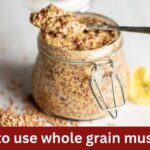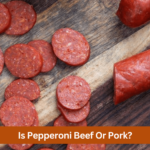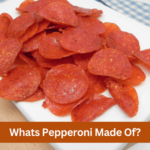In the culinary world, salt is not just a seasoning; it’s an essential ingredient that can make or break a dish. From enhancing flavors to preserving foods, salt plays a crucial role in cooking. However, not all salts are created equal. In this comprehensive guide, we’ll delve into the four main types of salt commonly used in kitchens around the world.
Understanding the Importance of Salt

Salt is one of the oldest and most essential ingredients in cooking, revered for its ability to transform and elevate flavors. Its importance extends beyond mere taste enhancement, encompassing various culinary functions that are crucial for achieving balanced and delicious dishes. Let’s delve deeper into why salt is a fundamental component of cooking:
Flavor Enhancement
At its core, salt enhances the natural flavors of food by interacting with taste receptors on the tongue. It has the unique ability to suppress bitterness and enhance sweetness, thereby creating a more enjoyable eating experience. Salt can also accentuate the savory notes in dishes, known as umami, making them more robust and satisfying.
Texture Modification
In addition to flavor enhancement, salt plays a vital role in modifying the texture of food. It draws out moisture from ingredients through osmosis, which can help tenderize meats and vegetables and improve their overall mouthfeel. In baking, salt controls the fermentation process by regulating yeast activity and strengthening gluten, resulting in better structure and texture in bread and pastries.
Preservation
For centuries, salt has been used as a natural preservative to extend the shelf life of perishable foods. Its ability to inhibit the growth of bacteria and other microorganisms makes it indispensable in curing meats, pickling vegetables, and preserving fish. By dehydrating and creating a hostile environment for pathogens, salt helps prevent food spoilage and ensures food safety.
Seasoning and Balance
Salt is a key seasoning agent that helps achieve balance and harmony in dishes. It acts as a flavor amplifier, allowing other ingredients to shine while providing a foundation of savory depth. Proper seasoning with salt is essential for bringing out the nuances of different ingredients and creating a well-rounded flavor profile. Whether used sparingly or liberally, salt adds complexity and dimension to culinary creations.
Cultural and Historical Significance
Beyond its culinary applications, salt holds cultural and historical significance in many societies around the world. It has been valued as a precious commodity, traded across vast distances and even used as currency in some civilizations. Salt production has shaped economies, influenced migration patterns, and fueled exploration throughout history. Today, salt continues to play a central role in global cuisine, reflecting diverse culinary traditions and preferences.
1. Kosher Salt
:max_bytes(150000):strip_icc()/GettyImages-1291435922-2000-210a8e28c67944d492b8eb8343705365.jpg)
Characteristics:
- Kosher salt is characterized by its coarse-grained and flaky texture, which sets it apart from other types of salt.
- Unlike table salt, kosher salt does not contain additives like iodine or anti-caking agents, making it a pure and natural seasoning.
- It is generally less pungent than table salt, with a milder flavor profile that allows it to complement dishes without overpowering them.
Best Uses:
- Finishing Salt: Kosher salt is an excellent choice as a finishing salt, sprinkled on dishes just before serving to add a final touch of flavor and texture.
- Brining and Curing: Its coarse texture makes kosher salt ideal for brining meats and curing fish, as it penetrates the surface more effectively than finer salts.
- Pickling: Kosher salt is often preferred for pickling vegetables due to its lack of iodine, which can cause undesirable discoloration in preserved foods.
Key Points:
- Granule Size: The granules of kosher salt are larger and flakier than those of table salt, which means they cannot be used interchangeably in recipes that rely on precise measurements.
- Saltiness Comparison: While kosher salt and table salt have similar saltiness by weight, their volume measurements differ due to variations in granule size.
- Chef’s Favorite: Kosher salt is favored by many chefs for its ease of handling and ability to adhere to food surfaces, making it ideal for seasoning meats and vegetables before cooking.
2. Table Salt
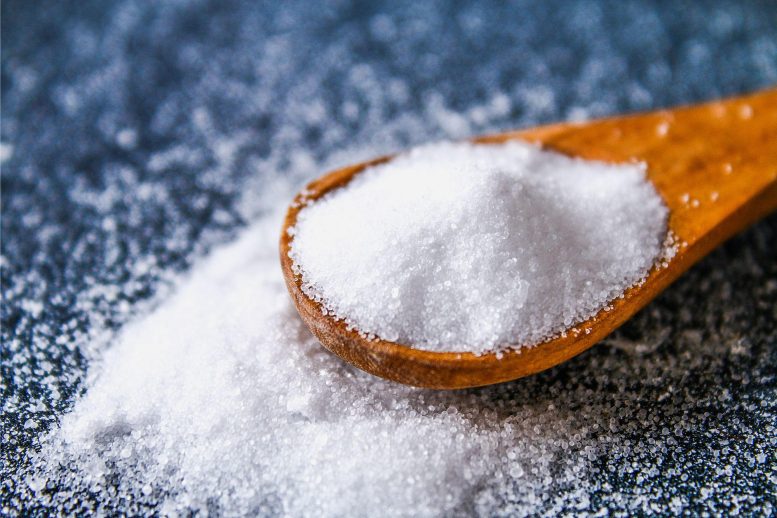
Characteristics:
- Table salt is the most common type of salt found in households and commercial kitchens worldwide.
- It is highly refined, typically sourced from salt mines, and undergoes processing to remove impurities and minerals.
- Anti-caking agents, such as calcium silicate or magnesium carbonate, are often added to prevent clumping and ensure a free-flowing consistency.
- Additionally, iodine, a vital nutrient for thyroid health, is commonly added to table salt as a dietary supplement.
Best Uses:
- Baking: Table salt is preferred for baking due to its fine texture and consistent saltiness, which allows for precise measurement and even distribution in recipes.
- General Cooking: It is suitable for most cooking applications, including seasoning soups, sauces, and stews, where its uniform granules dissolve quickly and evenly.
- Yeast Activation: Table salt plays a crucial role in bread-making by controlling yeast fermentation and strengthening gluten, resulting in properly risen and textured dough.
Key Points:
- Refinement Process: The refinement process strips table salt of its natural impurities and trace minerals, resulting in a pure and uniform product with a neutral flavor.
- Consistency: Table salt offers consistent saltiness and dissolution properties, making it a reliable choice for recipes that require precise seasoning.
- Health Considerations: While iodine fortification is beneficial for addressing iodine deficiency, some individuals may prefer iodine-free options for specific dietary preferences or health concerns.
3. Sea Salt

Characteristics:
- Sea salt is harvested through the evaporation of seawater, resulting in natural crystalline formations.
- Unlike table salt, sea salt is minimally processed and retains trace minerals such as magnesium, potassium, and calcium, which contribute to its unique flavor profile and color variations.
- It is available in various textures, ranging from fine to coarse, depending on the size of the crystals and the method of harvesting.
Best Uses:
- Seasoning: Sea salt is prized for its distinctive taste and mineral-rich composition, making it a preferred seasoning for enhancing the flavors of dishes.
- Finishing Salt: Coarse sea salt crystals are often used as a finishing touch on salads, grilled meats, and other dishes to add a crunchy texture and burst of flavor.
- Brining and Curing: Due to its natural purity and mineral content, sea salt is well-suited for brining meats and curing fish, imparting a subtle complexity to the final product.
Key Points:
- Flavor Variations: Sea salt exhibits nuances of flavor and aroma derived from its marine origins and mineral content, ranging from subtle sweetness to briny notes depending on the source.
- Health Benefits: While sea salt and table salt contain comparable levels of sodium chloride, sea salt may offer additional health benefits due to its mineral content, although the difference is minimal in practical terms.
- Gourmet Options: Specialty varieties of sea salt, such as Maldon sea salt and fleur de sel, are prized by chefs and food enthusiasts for their unique textures and flavors, adding a touch of elegance to culinary creations.
4. Coarse Salt
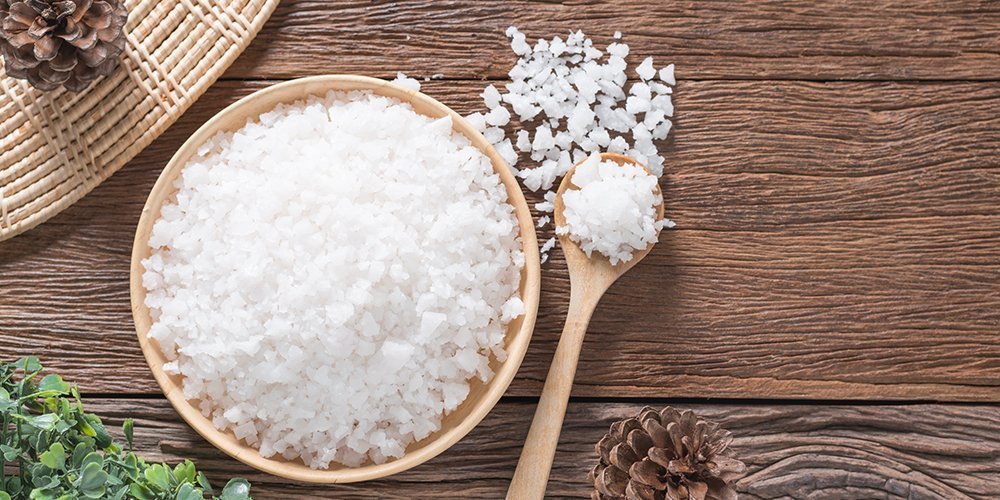
Characteristics:
- Coarse salt, as the name suggests, consists of large-grained salt crystals that are larger than those of table salt or sea salt.
- It can be sourced from either sea salt or mined salt deposits, depending on the specific production methods and geological formations.
- Due to its larger crystal size, coarse salt retains less moisture and is less prone to clumping, even without the addition of anti-caking agents.
Best Uses:
- Finishing Salt: Coarse salt is commonly used as a finishing salt, sprinkled over dishes just before serving to add a satisfying crunch and burst of flavor.
- Salt Crusts: Its coarse texture makes it ideal for creating salt crusts on meats, poultry, and fish, which helps seal in moisture and impart seasoning during cooking.
- Curing and Preserving: When a slower dissolution rate is desired, coarse salt is suitable for curing meats or preserving foods, as its large crystals penetrate the surface more gradually.
Key Points:
- Texture and Visual Appeal: The coarse texture of this salt variety adds both visual interest and tactile sensation to dishes, enhancing their overall presentation.
- Grinder Usage: Coarse salt is often kept in a salt grinder or mill to allow for easy customization of the salt particle size according to individual preferences and culinary applications.
- Versatile Application: Whether used as a finishing touch on grilled vegetables, a crust for prime rib, or a curing agent for salmon gravlax, coarse salt offers versatility and depth of flavor in various culinary contexts.
Conclusion
Each type of salt has its own unique characteristics and best uses in the kitchen. Whether you’re looking for a fine seasoning for delicate dishes or a robust salt for meat curing, there’s a salt variety to suit every taste and culinary need. Experimenting with different types of salt can elevate your cooking to new heights and help you discover exciting flavor combinations. So, the next time you reach for the salt shaker, consider the possibilities that each type of salt brings to your dishes. Happy cooking!



